Ever wondered, “Is willow a hardwood?” Dive into a journey unraveling the enigma of willow wood, exploring its uniqueness, strengths, and weaknesses. Ready to uncover the mystery? Read on!
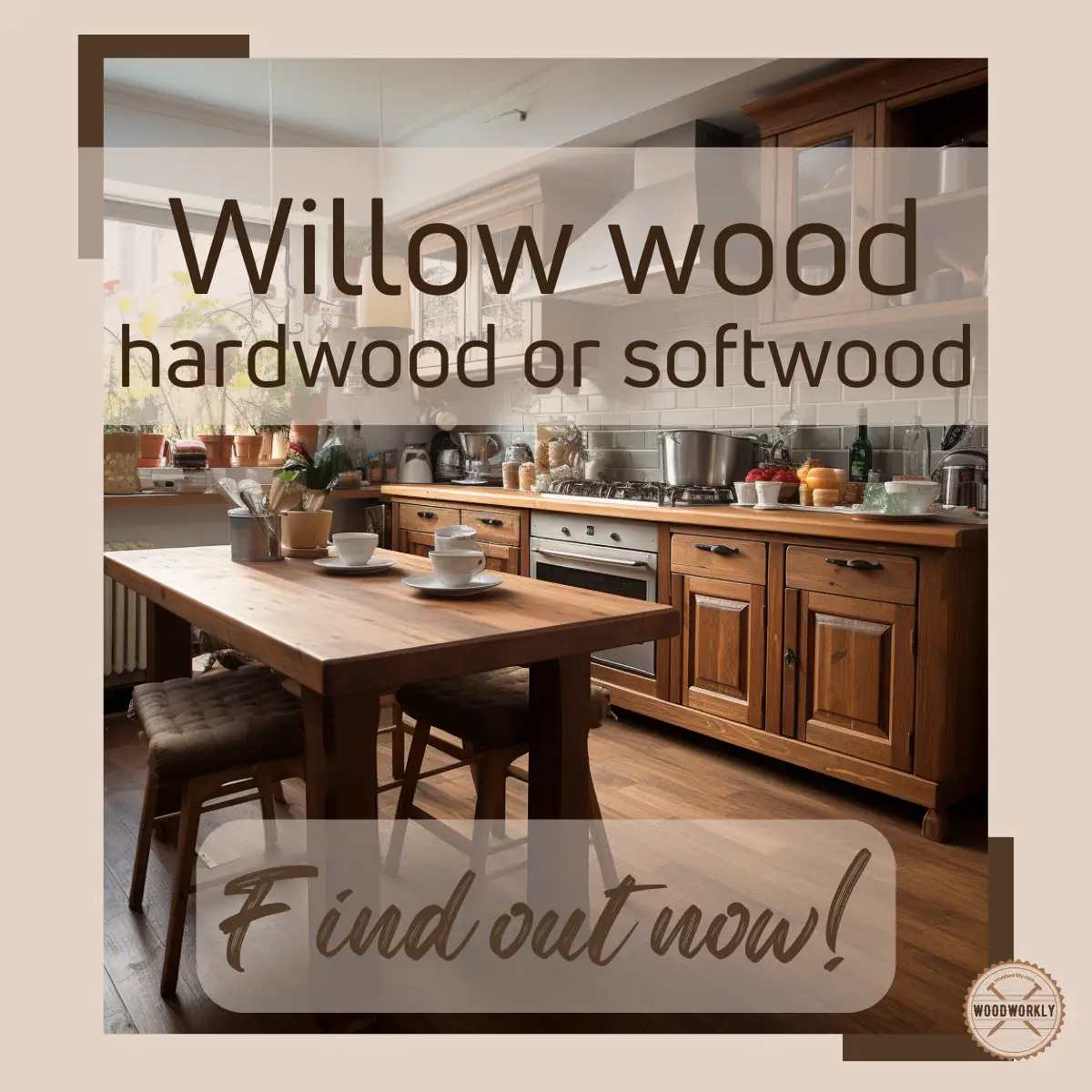
Willow wood is a moderately strong wood that is used for making furniture, boxes, crates, toys, and decorative items.
But many people question the hardness of Willow wood since it is so light in weight.

I had the same question and did deep research with the help of experts to find out the hardness of willow with the help of experts.
So, let’s find out, Is Willow a hardwood?
Yes, Willow is a hardwood that comes from a deciduous tree. Willow has a Janka hardness rating of 570 lbf (2,530 N) which is significantly softer than most hardwoods. Willow is a soft lightweight hardwood with low density and weak strength. But it has excellent shock resistance.
But that’s a quick snapshot!
This article will deeply explore whether is Willow hardwood, how hard Willow wood is, characteristic features of Willow wood with its pros and cons.
Furthermore, I’ll answer frequently asked questions as well.
Let’s jump in!

First of all, let’s have a quick look at what is willow wood,
What is Willow Wood?
Willow wood is derived from the trees of the genus Salix, commonly known as willow trees.
This type of wood is notably characterized by its lightweight and soft nature, yet it’s classified as a hardwood due to its origin from deciduous trees.
Willow wood showcases a beautiful palette of creamy white to light brown hues, adding an aesthetic touch to its physical appeal.
Willow wood is a soft hardwood, cherished for its lightweight, aesthetic appeal, and shock resistance, but also noted for its limitations in hardness and durability.
Now, let’s focus on its hardness in detail.
How Hard Is Willow?
Willow wood is a soft hardwood with relatively less hardness and less density than most hardwoods and some softwoods as well.
According to the Janka hardness rating, Willow wood has a hardness rating of 570 lbf (2,530 N) which is lesser than well-known woods such as Maple, Cherry, Ash, Cedar, and Yellow Pine.
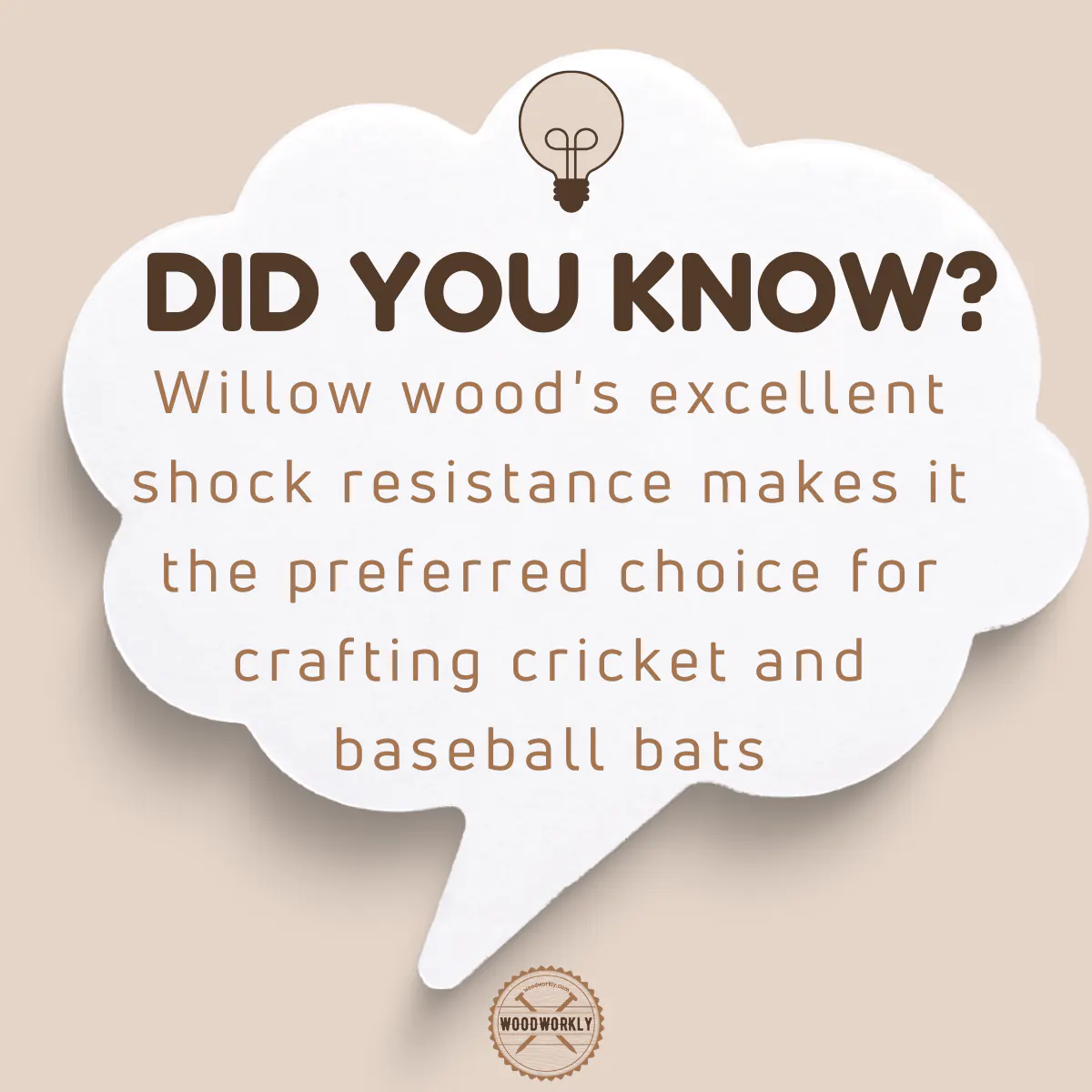
Janka hardness rating is the standard method of measuring the hardness of any wood on the planet.
It is calculated by considering the resistance of wood against wear and shear. For example, If a particular wood type has high wear and shear resistance, that means, its Janka hardness rating is high.
Density is also an important factor to consider in the hardness of wood.
Willow has a density of 340kg/m3 which is also lower than many other kinds of wood.
Overall, Willow wood can be considered a hardwood with softwood values. This is why we called Willow a soft hardwood. Same as Cherry and Cottonwood.
On the positive side because of being a soft hardwood, Willow is equipped with qualities of hardwoods and softwoods more or less.
Willow wood has excellent shock resistivity, and it is light in weight. This is helpful for making sports equipment such as cricket and baseball bats.
Because of is a soft hardwood, Willow wood tends to crack and split even with a little stress applied.
Willow is difficult to bend even after softening with steam due to the softness.
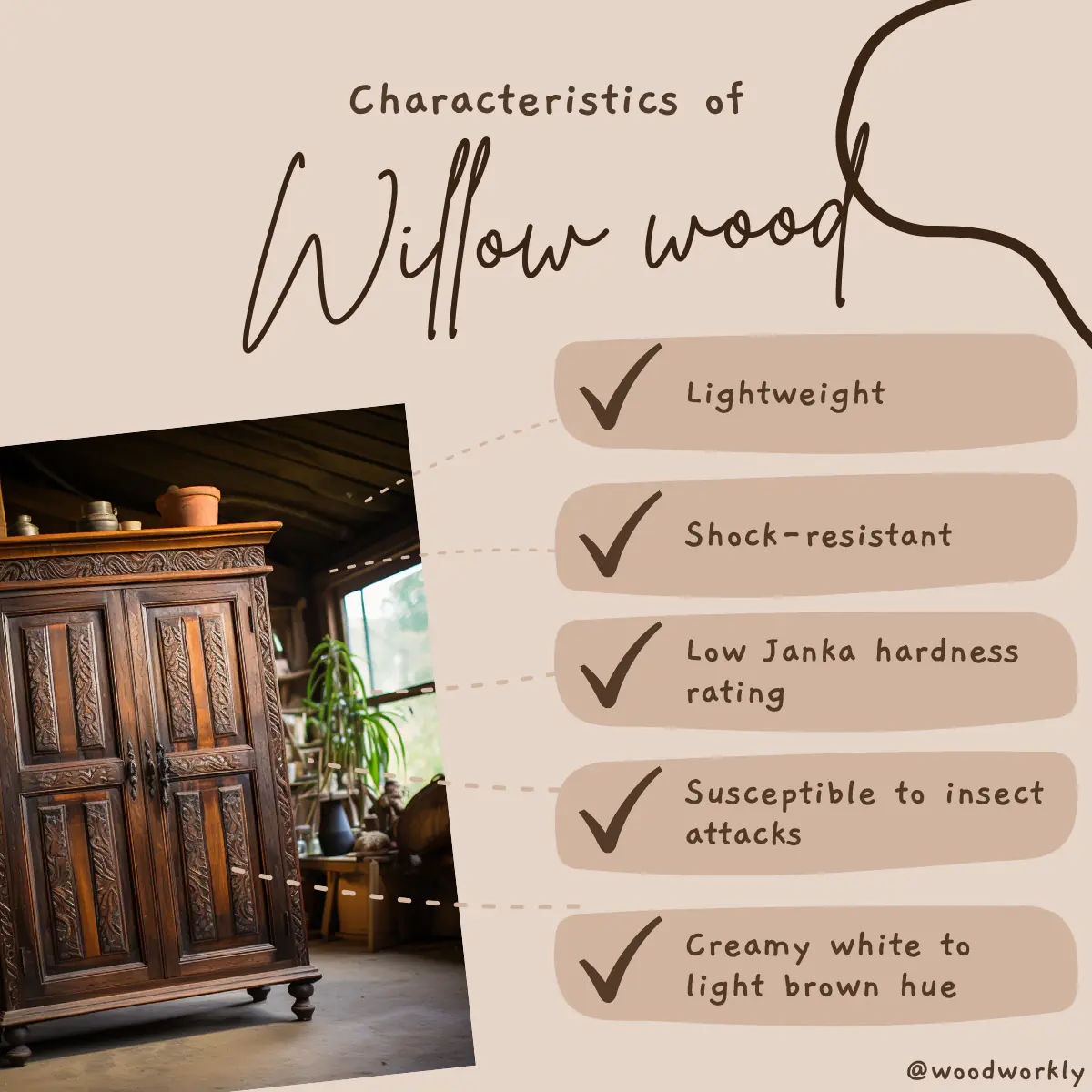
Hardness of Willow Compared to Other Woods
As per Janka’s hardness rating, Willow has a hardness rating of 570 lbf which is lower hardness than many hardwoods.
Have a look at the below chart to get a good idea about the hardness of Willow compared to other popular wood types.
| Wood Species | Hardness value |
| Brazilian Walnut | 3,684 lbf (16,390 N) |
| Red Mahogany, Turpentine | 2,697 lbf (12,000 N) |
| Brazilian Cherry, Jatoba | 2,350 lbf (10,500 N) |
| Golden Teak | 2,330 lbf (10,400 N) |
| Hickory, Pecan, Satinwood | 1,820 lbf (8,100 N) |
| Honey Locust | 1,580 lbf (7,030 N) |
| Hard Maple, Sugar Maple | 1,450 lbf (6,400 N) |
| White Oak | 1,360 lbf (6,000 N) |
| Ash (White) | 1,320 lbf (5,900 N) |
| American Beech | 1,300 lbf (5,800 N) |
| Red Oak (Northern) | 1,290 lbf (5,700 N) |
| Yellow Birch / Baltic birch | 1,260 lbf (5,600 N) |
| Teak | 1,155 lbf (5,140 N) |
| Black Walnut, North American Walnut | 1,010 lbf (4,500 N) |
| Cherry | 995 lbf (4,430 N) |
| Black Cherry, Imbuia | 950 lbf (4,200 N) |
| Red Maple | 950 lbf (4,200 N) |
| Larch | 830 lbf (3,690 N) |
| Yellow Pine | 870 lbf (3,870 N) |
| Douglas Fir | 710 lbf (3,158 N) |
| Silver Maple | 700 lbf (3,100 N) |
| Willow | 570 lbf (2,530 N) |
| Hemlock | 540 lbf (2,402 N) |
| Black Spruce | 520 lbf (2,313 N) |
| Cypress | 510 lbf (2,269 N) |
| Cottonwood | 430 lbf (1,913 N) |
| Redwood | 420 lbf (1,868 N) |
| Basswood | 410 lbf (1,823 N) |
| Engelmann Spruce | 390 lbf (1,735 N) |
| Sugar Pine | 380 lbf (1,690 N) |
| White Pine | 380 lbf (1,690 N) |
| Aspen | 350 lbf (1,557 N) |
| White Cedar | 320 lbf (1,423 N) |
As you can see the hardness of Willow is significantly lower than the woods that we mostly use.
But being less in hardness is important for some other projects as decorative items.
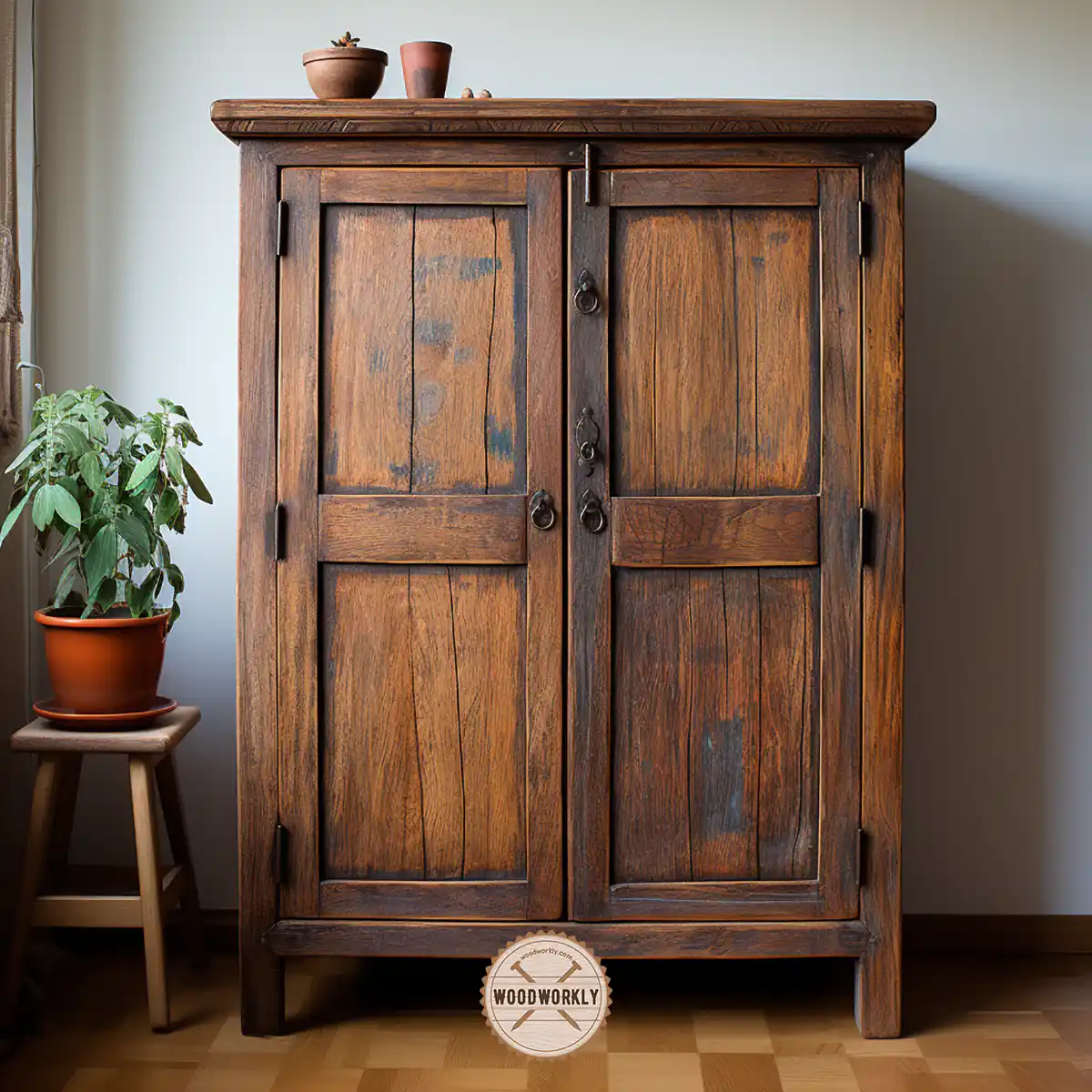
Let’s have a look at the hardness of Willow in terms of its characteristic features.
Willow Wood Characteristics
Willow wood is a beautiful woodworking material with pinkish-brown heartwood and yellowish-brown sapwood. Being attractive makes Willow wood stand out compared to other woods.
Willow wood is a soft hardwood with poor density, and it is significantly weak wood compared to its weight.
The positive side is its lightweight and excellent wood finishing properties.
Willow wood has a straight grain with a fine texture which makes it easy to stain and finish with almost any sealer.

Even though Willow is a hardwood, it has no rot or decay resistance as many other hardwoods in the same category.
Therefore, applying a proper finisher is a must before using Willow wood furniture, especially in outdoor environments.
But if your Willow wood furniture already starts to rot, better to remove the rotted area and restore wood using a proper product like Flex Seal.
Willow wood is prone to insect attacks and unable to withstand harsh weather conditions, temperature fluctuations, and humidity levels.
Borers, gypsy moths, and bugs love to eat and lay eggs on Willow wood surfaces. These insects destroy the wood both internally and externally.
Willow wood expands and contracts drastically upon environmental humidity and it destroys the dimensional stability of the wood which makes it unsuitable for outdoor furniture.
But after finishing properly, Yes, you can use willow wood for outdoor uses as well. It will be protected against outdoor elements.
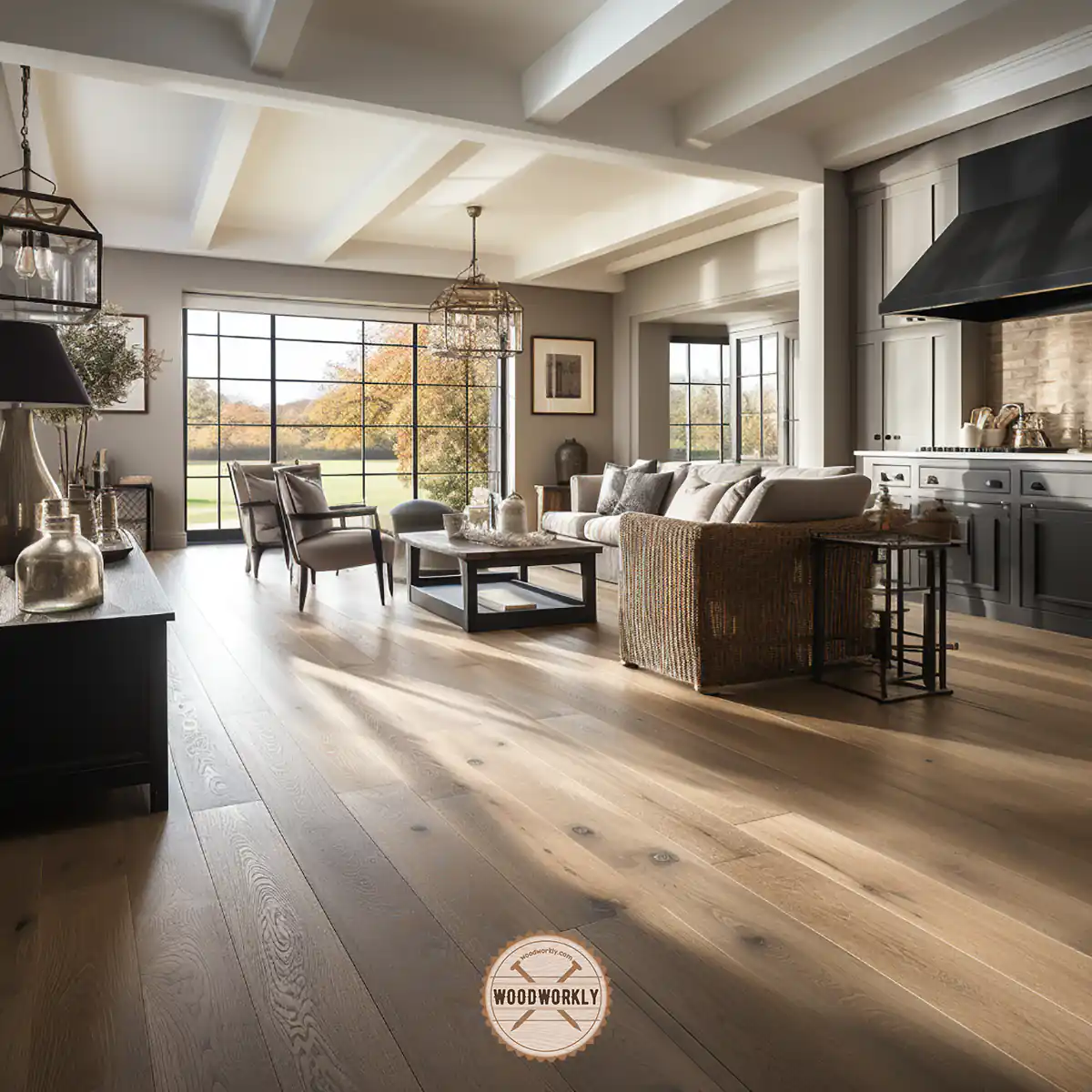
Willow wood has really poor durability and poor workability which makes it so hard to cut, nail, screw, and drill.
Working with hand tools and power tools is difficult since Willow tends to chip and tear away easily.
Plus, it tends to warp and crack when drying.
In order to keep the wood from warping you need to apply a proper sealant to make a barrier between the wood surface and outside air.
Here are the most significant qualities of Willow wood,
- Soft hardwood
- Prone to rot and decay
- Susceptible to insect attack
- No characteristic odor
- Poor workability
- Tear and chip away easily
- Low density
- Lightweight
- High shock resistance
- Crack and warp easily
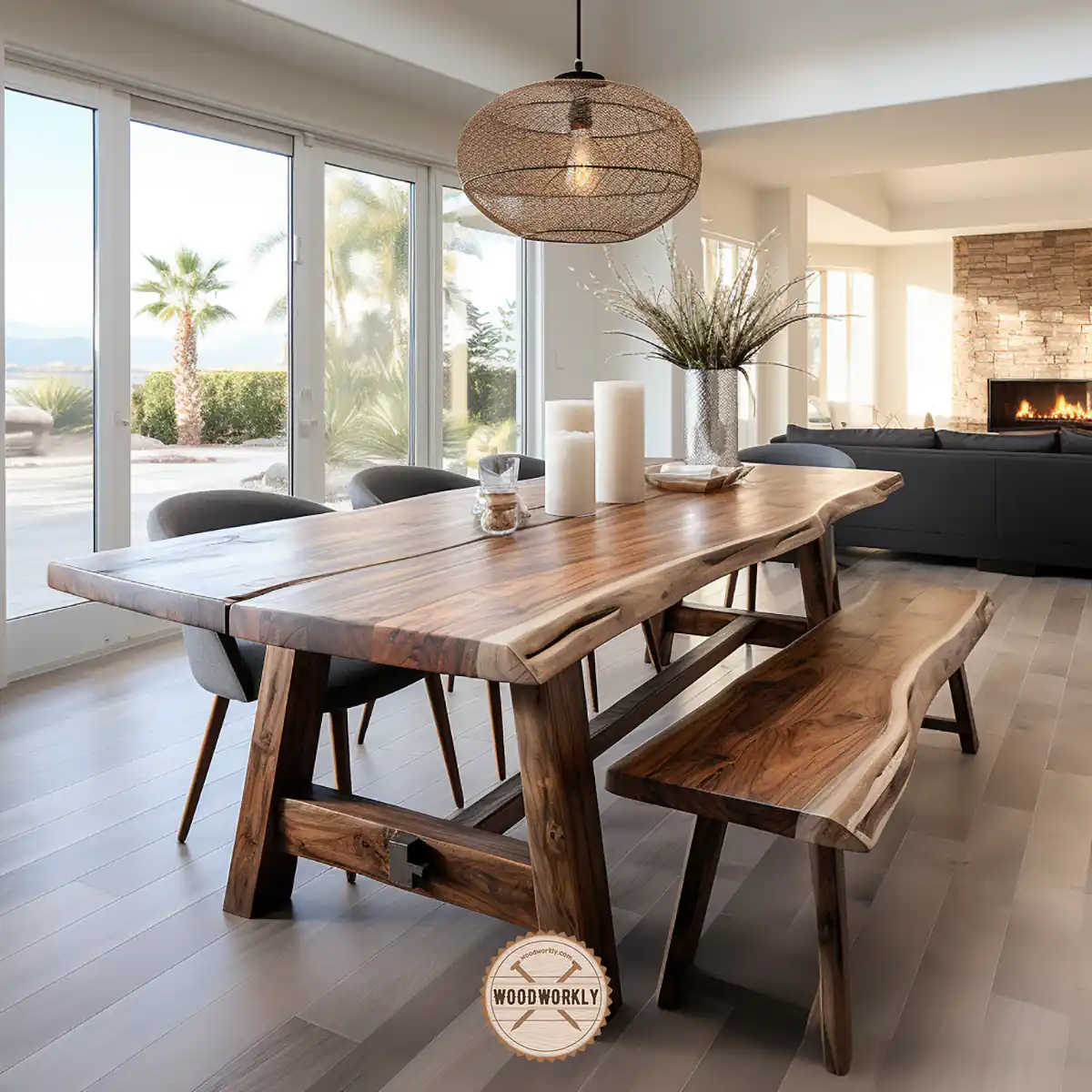
Properties of Willow Wood
Here are the main characteristic features of Willow wood,
| Color | Pinkish brown |
| Density | 340 kg/m3 |
| Hardness | Hardwood |
| Applications | Boxes, Furniture making, Sports equipment |
So, let’s have a quick look at the advantages and disadvantages of Willow wood as a hardwood.
Pros And Cons Of Willow Wood
| Pros | Cons |
| Lightweight | Poor hardness |
| Easy to seal and finish | Poor density |
| High shock resistance | No rot resistance |
| No characteristic odor | No decay resistance |
| Attractive wood | Prone to insect attacks |
| Sustainable | Poor weather resistance |
As you can see in terms of a woodworking perspective, Willow is not the best material you should go with.
There are some other soft hardwoods like Cherry and Poplar with better woodworking features than Willow wood you can get for a cheaper price.
But we still use Willow wood for various woodworking projects because of its excellent shock resistance. Also, finding lightweight hardwood is so hard nowadays.
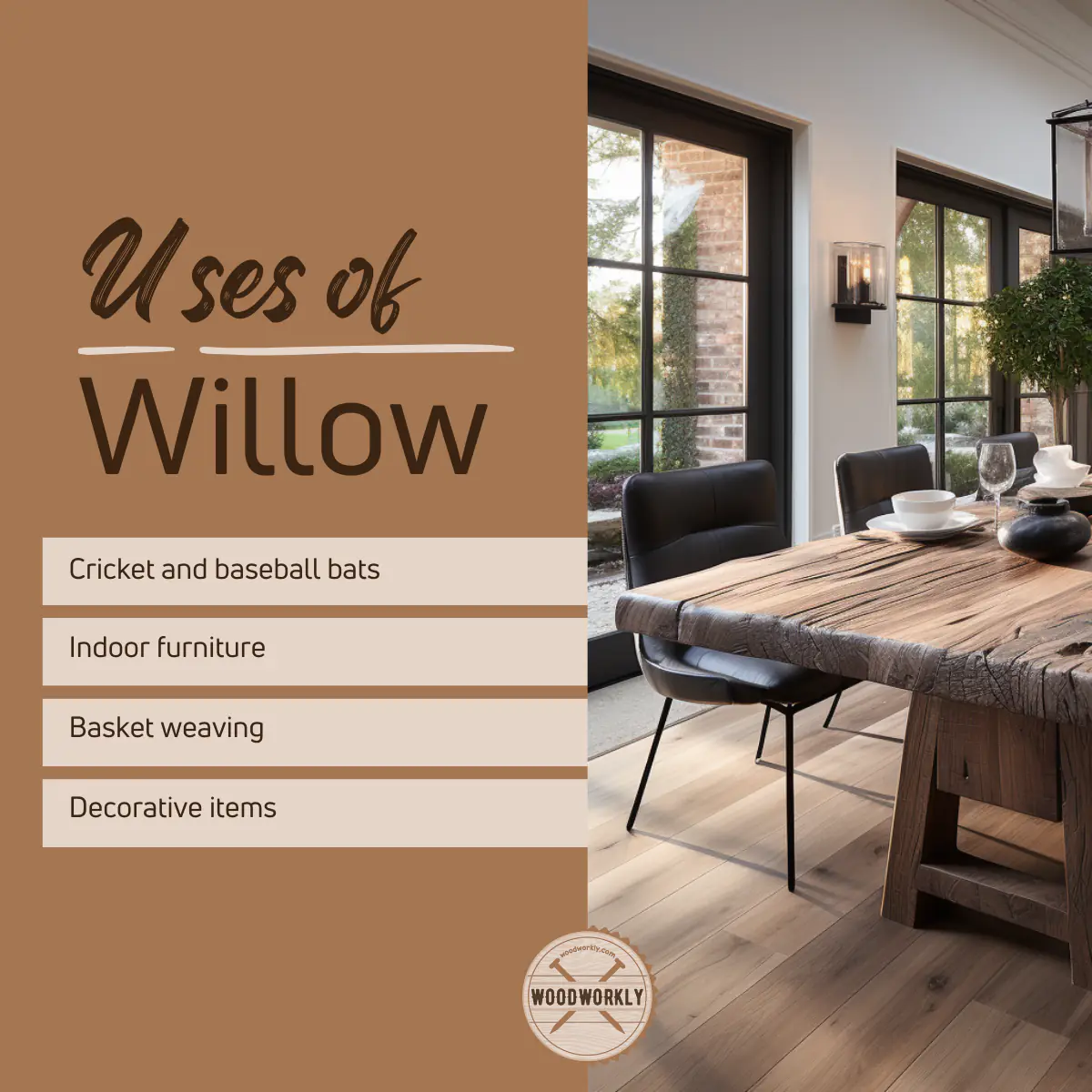
What Is Willow Wood Used For?
Willow wood is able to be used for small woodworking projects. Using Willow wood outdoors is not recommended because of its poor weather resistance.
Here are some common applications of Willow wood,
- Indoor furniture
- Sports equipment
- Decorative items
- Veneer
- Boxes and crates
- Panels
- Tool handles
- Toys
How Strong Is Willow Wood?
Willow wood is considered one of the weakest hardwoods. It is moderately strong compared to softwoods.
Willow cannot withstand stress, and it is unable to carry a load like other hardwoods.
Willow wood is a weak wood against its weight. Therefore, the compressive strengths and flexural strengths of Willow wood are poor.
Having poor strengths is not acceptable as hardwood. But you can get used to Willow wood by using it only for applications that don’t carry loads like decorative items.
The compressive strength and bending strength of Willow wood are as follows,
- The compressive strength of Willow wood is 3.40 Mpa
- The bending strength of Willow wood is 9.80 Gpa
Better not to use Willow wood for applications that carry a lot of load and stress. The wood can break quite easily.
That’s it, folks! Hope you have gained a good understanding of, whether is Willow a hardwood and why can’t we use it for outdoor and construction projects.
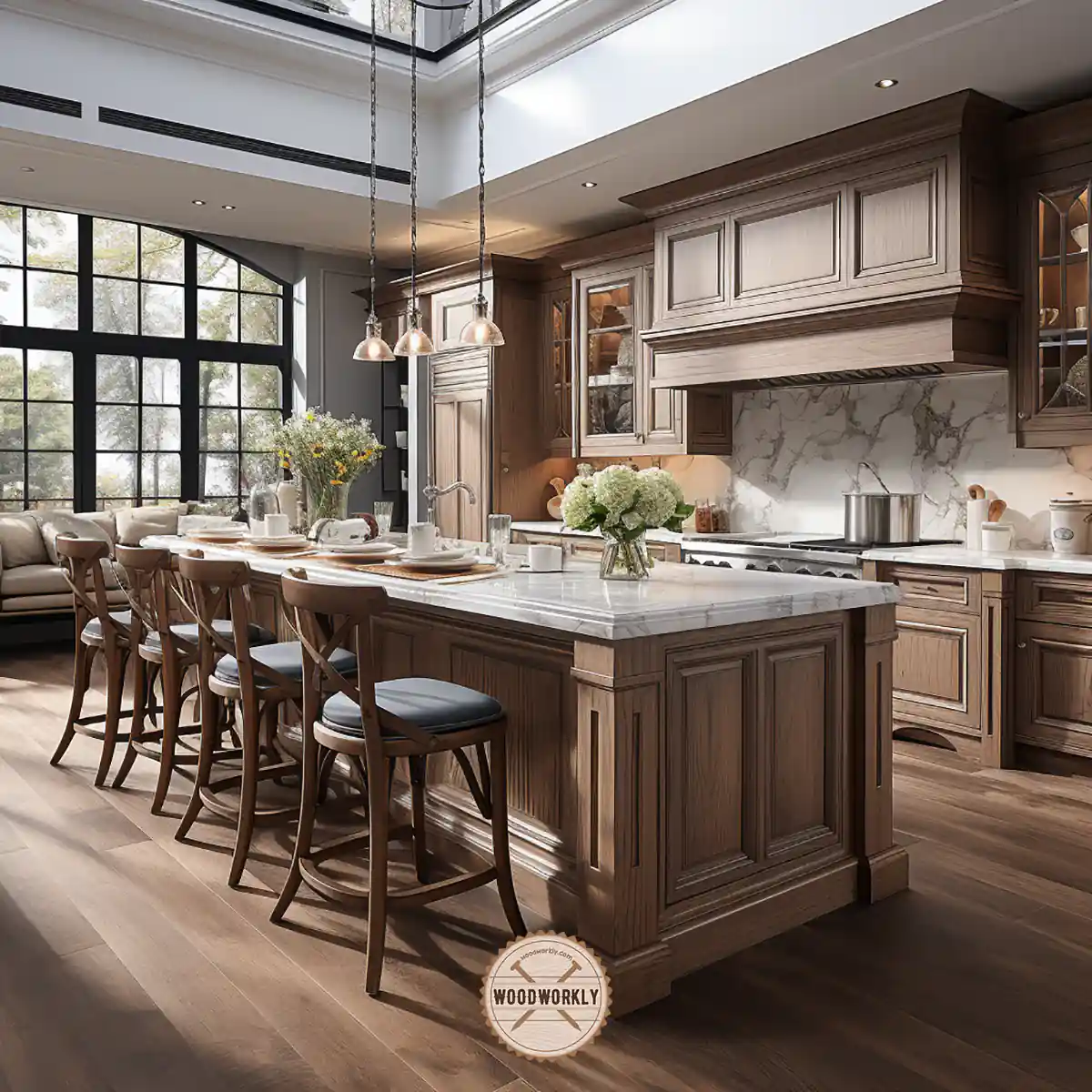
Is Willow Wood Durable?
Willow wood is not a durable hardwood since it is susceptible to insect attacks, prone to rotting and decaying. Outside moisture can easily penetrate into wood and damage internally and externally.
Better not to use Willow wood for outdoor furniture since it cannot tolerate harsh weather conditions and extreme temperature levels.
Wood tends to crack and warp easily upon drying and applying a proper sealer is a must to keep Willow woodwork or furniture for a long time.
With proper finishing and sealing, you’ll be able to keep Willow wood furniture with no effects from the outside environment.
Is Willow Hard To Split?
Some areas of Willow wood are easy to split but others don’t because its configurations of wood fibers are not the same across the wood.
Splitting through crocked branches and crotches is much harder due to the fiber arrangement.
According to the experts, better to split Willow wood between winter to early spring since when the wood is cooler it may have less moisture content.
That makes the wood easier to spit and use for firewood.
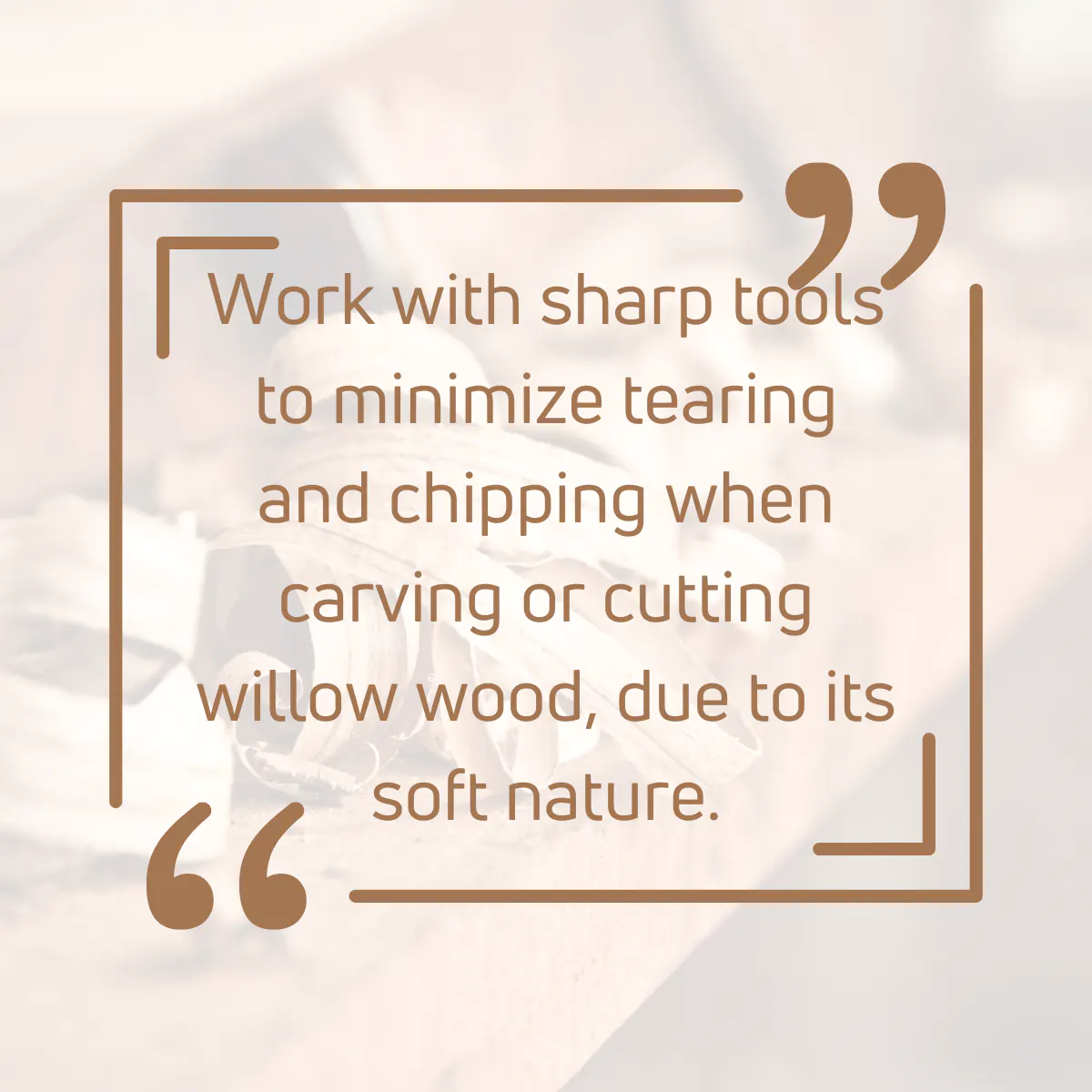
Is Willow Wood Tough?
Even though Willow wood is hardwood, it is soft and has no toughness at all. It has poor strength compared to its weight.
But Willow wood has excellent shock resistance which is useful when making cricket bats and baseball bats.
Is Willow Harder Than Oak?
Oak is significantly harder than Willow. Both Red Oak and White Oak are harder, denser, more durable, and stronger than Willow wood.
Therefore, Willow wood can easily replace oakwood in terms of its hardness.
According to the Janka hardness ratings, the hardness of Willow and Oak is as follows,
| Wood Type | Hardness |
| Willow | 570 lbf |
| Red Oak | 1,290 lbf |
| White Oak | 1,360 lbf |
As you can see both Red Oak and White Oak are more than two times harder than Willow wood.
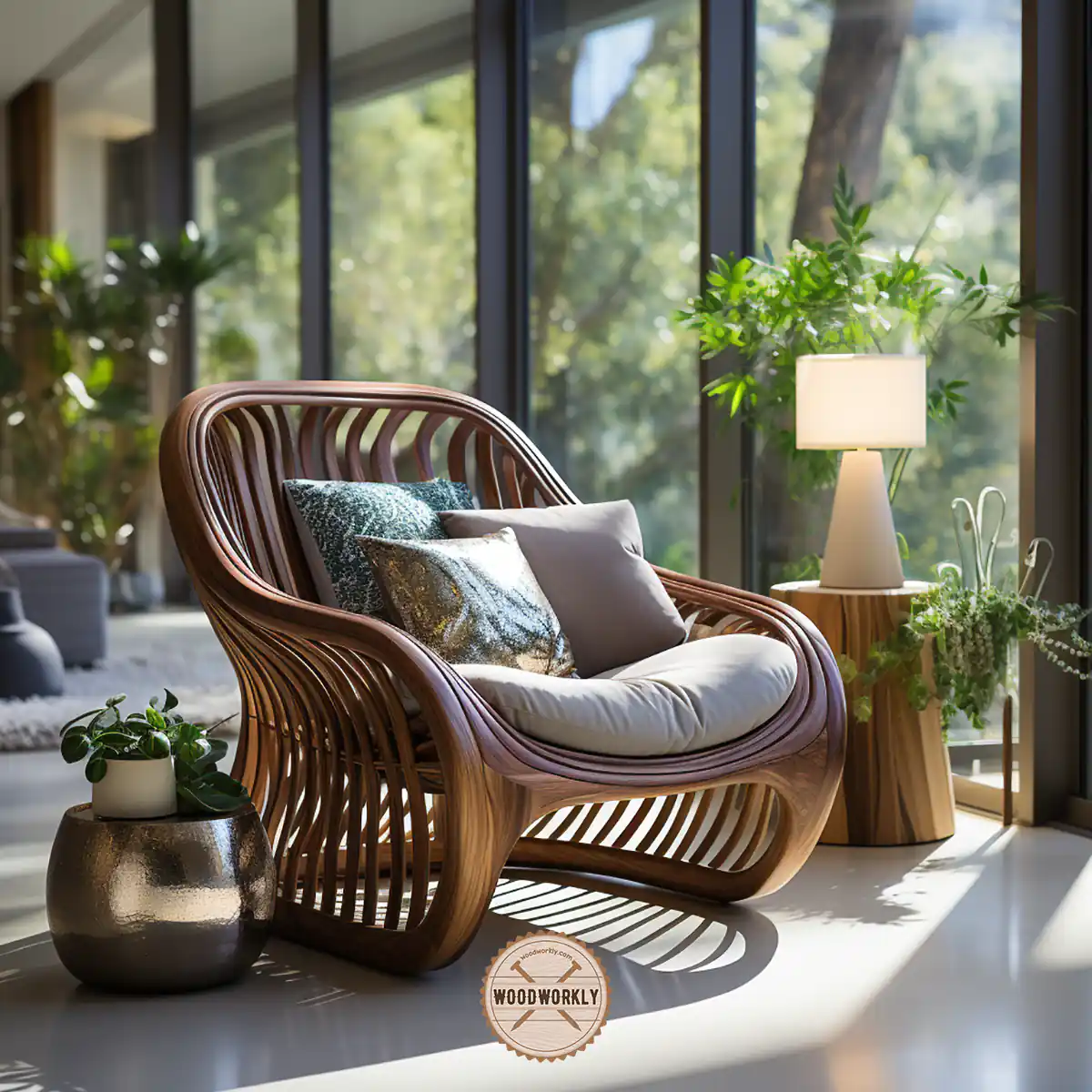
Let’s answer some frequently asked questions.
FAQs
Is willow considered a hardwood or softwood?
Willow is classified as a hardwood because it comes from deciduous trees, despite having physical properties akin to softwoods, including its light weight and low density.
How hard is willow wood compared to other hardwoods like oak or maple?
Willow is significantly softer, with a Janka hardness rating of 450-670 lbf, making it less hard than popular hardwoods like oak and maple.
What are the common uses of willow wood given its soft nature?
Willow wood is often used for making cricket and baseball bats, indoor furniture, and decorative items due to its shock resistance and workability.
Can willow wood withstand outdoor environmental conditions?
It has limited outdoor applications, as it is prone to damage from harsh weather conditions and insects, though its resistance to rot can be enhanced with proper treatments.
How does the cost of willow wood compare to other types of wood?
The cost can vary, but willow is often more affordable due to its softness and abundance, though the price can fluctuate based on quality and availability.
Is willow wood easy to work with for carving and crafting?
Yes, its straight grain and soft texture make it relatively easy to carve and craft, though it can also be prone to chipping and tearing.
Does willow wood have a distinctive color or appearance?
Willow wood showcases a creamy white to light brown hue with a straight grain, making it aesthetically pleasing for various applications.
Is willow wood a good choice for firewood?
It is not the best option for firewood, as it burns quickly, produces less heat, and can create excess smoke and residue.
How does willow wood’s shock resistance impact its applications?
The excellent shock resistance makes willow wood ideal for making sports equipment, such as cricket and baseball bats.
Is willow wood prone to warping or cracking?
Yes, willow wood can warp and crack easily, especially upon drying, but applying a proper sealant can mitigate these issues.
Did I cover all you wanted to know about: Is Willow A Hardwood?
In this article, I have deeply discussed, whether is Willow a hardwood, how hard Willow wood is compared to other popular wood types, characteristic features of Willow wood with its pros and cons.
Willow is a hardwood, derived from deciduous trees. However, it’s softer and lighter compared to typical hardwoods, with a Janka hardness rating of 450-670 lbf. Its notable features include shock resistance and workability, making it suitable for specific applications like sports equipment and indoor furniture.
Furthermore, I’ve answered frequently asked questions as well.
Hope you have gained good knowledge about the hot topic, is Willow a hardwood with all the details regarding Willow wood.
Try to use Willow wood for making cricket and baseball bats and see how light and useful it is for certain applications. Happy woodworking!